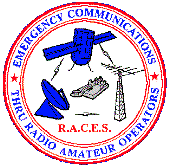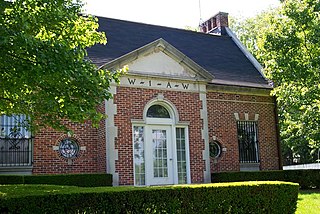Related Research Articles

The Federal Communications Commission (FCC) is an independent agency of the United States government that regulates communications by radio, television, wire, satellite, and cable across the United States. The FCC maintains jurisdiction over the areas of broadband access, fair competition, radio frequency use, media responsibility, public safety, and homeland security.

The Communications Act of 1934 is a United States federal law signed by President Franklin D. Roosevelt on June 19, 1934, and codified as Chapter 5 of Title 47 of the United States Code, 47 U.S.C. § 151 et seq. The act replaced the Federal Radio Commission with the Federal Communications Commission (FCC). It also transferred regulation of interstate telephone services from the Interstate Commerce Commission to the FCC.

Citizens band radio is a land mobile radio system, a system allowing short-distance one-to-many bidirectional voice communication among individuals, using two-way radios operating near 27 MHz in the high frequency or shortwave band. Citizens band is distinct from other personal radio service allocations such as FRS, GMRS, MURS, UHF CB and the Amateur Radio Service. In many countries, CB operation does not require a license and may be used for business or personal communications.

Pirate radio is a radio station that broadcasts without a valid license. In some cases, radio stations are considered legal where the signal is transmitted, but illegal where the signals are received—especially when the signals cross a national boundary. In other cases, a broadcast may be considered "pirate" due to the nature of its content, its transmission format, or the transmit power (wattage) of the station, even if the transmission is not technically illegal. Pirate radio is sometimes called bootleg radio, clandestine radio or free radio.
The American Radio Relay League (ARRL) is the largest membership association of amateur radio enthusiasts in the United States. ARRL is a non-profit organization and was co-founded on April 6, 1914, by Hiram Percy Maxim and Clarence D. Tuska of Hartford, Connecticut. The ARRL represents the interests of amateur radio operators before federal regulatory bodies, provides technical advice and assistance to amateur radio enthusiasts, supports a number of educational programs and sponsors emergency communications service throughout the country. The ARRL has approximately 161,000 members. In addition to members in the US, the organization claims over 7,000 members in other countries. The ARRL publishes many books and a monthly membership journal called QST.

In the United States and Canada, the Amateur Radio Emergency Service (ARES) is a corps of trained amateur radio operator volunteers organized to assist in public service and emergency communications. It is organized and sponsored by the American Radio Relay League and the Radio Amateurs of Canada.
The amateur auxiliary was an American amateur radio organization operated by the American Radio Relay League between 1994 and 2019 that was authorized by and worked in conjunction with the Federal Communications Commission (FCC). The Auxiliary consisted of official observer volunteer amateur radio operators who monitored amateur radio service frequencies. This was one way in which the FCC encouraged amateur radio operators in the United States to self-police.

The Radio Amateur Civil Emergency Service (RACES) is an emergency radio service authorized in Part 97.407 of the Federal Communications Commission (FCC) rules and regulations governing amateur radio in the United States.
The Radio Act of 1912, formally, known as "An Act to Regulate Radio Communication", is a United States federal law which was the country's first legislation to require licenses for radio stations. It was enacted before the introduction of broadcasting to the general public, and was eventually found to contain insufficient authority to effectively control this new service, so the Act was replaced and the government's regulatory powers increased by the passage of the Radio Act of 1927.
LowFER refers to experimental radio communication practiced by hobbyists on frequencies below 300 kHz, a part of the radio spectrum known as low frequency. The practitioners are known as "LowFERs".

In times of crisis and natural disasters, amateur radio is often used as a means of emergency communication when wireline, cell phones and other conventional means of communications fail.

In the United States, amateur radio licensing is governed by the Federal Communications Commission (FCC). Licenses to operate amateur stations for personal use are granted to individuals of any age once they demonstrate an understanding of both pertinent FCC regulations and knowledge of radio station operation and safety considerations. There is no minimum age for licensing; applicants as young as five years old have passed examinations and were granted licenses.

W1AW is both the amateur radio call sign and the primary operating station of the American Radio Relay League (ARRL). This station, which is commonly called the Hiram Percy Maxim Memorial Station, is located on the grounds of ARRL Headquarters in Newington, Connecticut. It was inspired by Maxim's 1AW callsign which predated the use of the AA-AL, K, N and W prefixes. The station routinely transmits bulletins and Morse code practice using common amateur radio frequencies. During a communications emergency bulletins are transmitted hourly in order to keep amateur radio operators informed.
Winlink, or formally, Winlink Global Radio Email, also known as the Winlink 2000 Network, is a worldwide radio messaging system that uses amateur-band radio frequencies and government frequencies to provide radio interconnection services that include email with attachments, position reporting, weather bulletins, emergency and relief communications, and message relay. The system is built and administered by volunteers and is financially supported by the Amateur Radio Safety Foundation.
The Shuttle Amateur Radio Experiment (SAREX), later called the Space Amateur Radio Experiment, was a program that promoted and supported the use of amateur ("ham") radio by astronauts in low Earth orbit aboard the United States Space Shuttle to communicate with other amateur radio stations around the world. It was superseded by the Amateur Radio on the International Space Station (ARISS) program. SAREX was sponsored by NASA, AMSAT, and the ARRL.
The history of amateur radio, dates from the dawn of radio communications, with published instructions for building simple wireless sets appearing at the beginning of the twentieth century. Throughout its history, amateur radio enthusiasts have made significant contributions to science, engineering, industry, and social services. Research by amateur radio operators has founded new industries, built economies, empowered nations, and saved lives in times of emergency.
In the United States, the Citizens Band Radio Service (CBRS), commonly called citizens band radio, is one of several personal radio services defined under Title 47 of the Code of Federal Regulations, Part 95. It is intended to be a two-way voice communication service for use in personal and business activities of the general public, and has a reliable communications range of several miles, though the range is highly dependent on type of radio, antenna and propagation.
The 13 centimeter, 2.3 GHz or 2.4 GHz band is a portion of the UHF (microwave) radio spectrum internationally allocated to amateur radio and amateur satellite use on a secondary basis. The amateur radio band is between 2300 MHz and 2450 MHz, and thereby inside the S-band. The amateur satellite band is between 2400 MHz and 2450 MHz, and its use by satellite operations is on a non-interference basis to other radio users. The license privileges of amateur radio operators include the use of frequencies and a wide variety of modes within these ranges for telecommunication. The allocations are the same in all three ITU Regions.

Amateur radio, also known as ham radio, is the use of the radio frequency spectrum for purposes of non-commercial exchange of messages, wireless experimentation, self-training, private recreation, radiosport, contesting, and emergency communications. The term "amateur" is used to specify "a duly authorized person interested in radioelectric practice with a purely personal aim and without pecuniary interest" ; and to differentiate it from commercial broadcasting, public safety, or professional two-way radio services.
The 630-meter amateur radio band is a frequency band allocated by the International Telecommunication Union (ITU) to amateur radio operators, and it ranges from 472–479 kHz, or equivalently 625.9–635.1 meters wavelength. It was formally allocated to amateurs at the 2012 World Radiocommunication Conference (WRC-12). The band is available on a secondary basis in all ITU regions with the limitation that amateur stations have maximum radiated power of 1 watt effective isotropic radiated power (EIRP); however, stations more than 800 km from certain countries may be permitted to use 5 watts EIRP.
